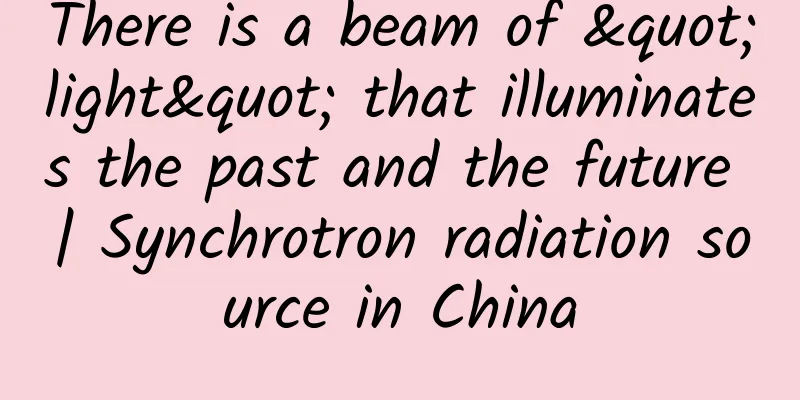There is a beam of "light" that illuminates the past and the future | Synchrotron radiation source in China

|
Produced by: Science Popularization China Author: Ziqian Producer: China Science Expo A seat at the table, BEPC's difficult entrepreneurial journey Four generations living together, HEPS continues to write new glories Synchrotron radiation has a history of more than 70 years since it was first discovered. From being "disliked" at first to being "loved" now, people's attitude towards synchrotron radiation has also undergone a huge change. The original synchrotron radiation source was "parasitic" on the particle collider, and synchrotron radiation research was carried out on the basis of existing particle accelerators. This is what we call the first generation of synchrotron radiation sources. The second generation of light sources is a dedicated synchrotron radiation source that no longer relies on particle colliders and particle physics research. The third generation of light sources uses a large number of inserts, which improves the performance of synchrotron radiation. At present, synchrotron radiation sources have developed to the fourth generation. China's synchrotron radiation has also gone through four generations of development. At that time, in 1977, the construction of synchrotron radiation facilities was included in the national science and technology development plan; now, on March 14, 2023, the "13th Five-Year Plan" national major scientific and technological infrastructure, China's fourth-generation synchrotron radiation source - the High Energy Synchrotron Radiation Source (HEPS) linear accelerator, fully emitted beams and successfully accelerated the first electron beam. This is another important milestone in the construction of the HEPS device and an important milestone in the development of China's synchrotron radiation. This issue will talk about the development of China's synchrotron radiation source. Inside the HEPS linear accelerator tunnel (Image source: Institute of High Energy Physics, Chinese Academy of Sciences) First generation: Beijing Synchrotron Radiation Facility - a light source "parasitic" on the Beijing Electron-Positron Collider In August 1972, Zhang Wenyu and 18 other scientific and technological workers wrote to Premier Zhou Enlai, expressing their opinions and hopes for the development of China's high-energy physics research. On September 11, 1972, Premier Zhou Enlai instructed in his reply: "This matter can no longer be delayed... High-energy physics research and pre-production research of high-energy accelerators should become one of the main projects that the Academy of Sciences should focus on." In October 1988, the Beijing Electron-Positron Collider was built at the Institute of High Energy Physics of the Chinese Academy of Sciences. Three years later, in 1991, the Beijing Synchrotron Radiation Facility (BSRF) was also established. Synchrotron radiation was drawn out from multiple points along the tangent direction, and corresponding laboratories were also built around the accelerator. Premier Zhou's reply (Image source: Institute of High Energy Physics, Chinese Academy of Sciences) At the beginning of its construction, the Beijing Synchrotron Radiation Facility was open to users. Its research content covers different disciplines and fields such as materials science, condensed matter physics, chemistry, chemical engineering, life science, medicine, geology, resources, environmental science, microelectronics and micromechanical technology. In the more than 30 years of operation, it has produced many important scientific research results. One of the most important results is that in the spring of 2003, SARS spread rapidly across the country, and the research on anti-SARS virus drugs was imminent. In June 2003, the research team led by Professor Rao Zihe of Tsinghua University, which built the first protein crystal structure research beamline and experimental station in China at the end of 2002, cracked the crystal structure of the main protease of SARS coronavirus, and then used synchrotron radiation experiments to obtain effective drug target molecules, providing important information for the development of drugs to treat SARS virus. As the first large-scale synchrotron radiation facility built and put into use in my country, the Beijing Synchrotron Radiation Facility has been successfully operating for more than 30 years. Although it is the first generation of synchrotron radiation source, its performance has been close to that of the second generation of synchrotron radiation sources after continuous improvement and upgrading. Today, this "backward" light source is still producing results, and it can be said that it is still going strong! Schematic diagram of the beamline and experimental station of Beijing Synchrotron Radiation Facility (Image source: http://bsrf.ihep.cas.cn/keyanchengguo/nianbao/201507/P020150713624664899951.pdf) Second generation: Hefei Synchrotron Radiation Light Source - specially designed for synchrotron radiation applications The main disadvantage of the first generation of synchrotron radiation sources is that they are "parasitic" on particle accelerators, and the main task of particle accelerators is to conduct high-energy physics experiments. They cannot operate according to the requirements of synchrotron radiation, and the actual machine time that can be used for experiments is greatly limited. Therefore, the Beijing Synchrotron Radiation Facility is only used for about 3 months a year, which is far from meeting the needs of scientific research. At this time, China's second generation synchrotron radiation source, the Hefei Synchrotron Radiation Light Source, was designed specifically for the application of synchrotron radiation. In fact, the Hefei Synchrotron Radiation Source and the Beijing Synchrotron Radiation Source were built basically at the same time. They were completed and began to emit light in 1989. It is also the first dedicated synchrotron radiation source built independently in my country. Its advantageous energy range is the vacuum ultraviolet and soft X-ray bands. The electron beam energy is up to 0.8 GeV, and the natural emittance is less than 40 nm•rad (although we hope that all electrons move on the same orbit in the storage ring, there will always be deviations in reality. Most real electrons deviate from the ideal orbit, so the electron bunch has a certain size and divergence angle. The product of these two is called "emitter". Obviously, the smaller the emittance, the more concentrated the light is and the better the light source performance is). Although it is a second-generation light source, it was built relatively early. Like the Beijing Synchrotron Radiation Facility, the performance and machine hours of the Hefei Synchrotron Radiation Facility are far from meeting the needs of scientific research. In addition, the energy of the Hefei light source is relatively low, and it mainly conducts research on vacuum ultraviolet and soft X-rays, and cannot produce hard X-rays. Hefei Light Source Synchrotron Radiation Hall (Image source: National Synchrotron Radiation Laboratory, University of Science and Technology of China) A corner of the Hefei Synchrotron Radiation Light Source storage ring (Image source: National Synchrotron Radiation Laboratory, University of Science and Technology of China) The third generation: Shanghai Synchrotron Radiation Light Source - a dedicated light source with low emittance and extensive use of inserts By the 1990s, the third generation of synchrotron radiation sources had appeared internationally. This generation of light sources made extensive use of inserts - a series of periodically arranged magnets with the same north and south poles. The emissivity of the light source was very small, the quantity was stable over a long period of time, the brightness was very high, and the quality in polarization and coherence was also excellent. In December 2004, the Shanghai Synchrotron Radiation Source started construction and was put into operation in 2009. It is the first third-generation synchrotron radiation source in mainland China (the third-generation light source in Taiwan, China, the Taiwan Light Source, was built in 1994). The Shanghai Light Source has increased the energy of the electron beam to 3.5 GeV, while reducing the emittance to 4 nm•rad, which is much lower than the Hefei Light Source. Shanghai Synchrotron Radiation Facility (Image source: Shanghai Zhangjiang Advanced Light Source Large Scientific Facility Cluster) In addition to the Shanghai Light Source, DIAMOND in the UK, SOLEIL in France, ALBA in Spain, and NSLS-II in the United States are also representative third-generation medium-energy synchrotron radiation sources. In early 2020, Chinese researchers used the Shanghai Light Source to take the lead in resolving the high-resolution structure of a key protein of the new coronavirus. Crystal structure of the complex between the main hydrolase protein of the new coronavirus and N3 (Image source: Modern Physics Knowledge Magazine https://www.ccnta.cn/article/8242.html) The fourth generation: high-energy synchrotron radiation source - brighter light illuminates the microscopic world At present, the world has developed the fourth generation of synchrotron radiation sources. This generation of light sources is based on diffraction-limited storage ring technology. The electron beam emittance is 1-2 orders of magnitude lower than the previous generation, approaching or even reaching the diffraction-limited emittance of X-rays, while the average brightness is higher. In fact, it was not until around 2010 that breakthroughs in the key physics and technology of diffraction-limited storage rings made the realization of diffraction-limited storage rings possible. Sirius in Brazil, ESRF-EBS in Europe, APS-U in the United States, etc. are all fourth-generation light sources. Currently under construction The High Energy Photon Source (HEPS) under construction in Huairou, Beijing is the fourth-generation synchrotron radiation source. HEPS was approved by the National Development and Reform Commission and built by the Institute of High Energy Physics of the Chinese Academy of Sciences. It is a major national scientific and technological infrastructure in the "13th Five-Year Plan". All preliminary preparations were completed in mid-2019, and construction started on June 29. The construction period is about 6.5 years, and it is expected to be completed and accepted by the end of 2025. The High Energy Synchrotron Radiation Source (HEPS) is a high-performance high-energy synchrotron radiation source with an electron energy of 6 GeV and an emittance of less than or equal to 0.06 nm·rad. Its primary goal is to provide high-energy, high-brightness hard X-rays to meet the needs of research related to the national development strategy. For example, research on aerospace engine materials and nuclear materials must rely on this high-performance X-ray. At the same time, it will also provide a better support platform for the industrial and basic science fields. After completion, this will be China's first high-energy synchrotron radiation source, and it will also be one of the brightest fourth-generation synchrotron radiation sources in the world. It will complement the existing light sources in my country in terms of energy range, and it will be of great significance to enhance my country's original innovation capabilities in the fields of national development strategy, cutting-edge basic science, and high technology. High-energy synchrotron radiation source (effect picture) (Image source: Institute of High Energy Physics, Chinese Academy of Sciences) On March 14, 2023, the High Energy Synchrotron Radiation Source (HEPS) linear accelerator emitted a beam at full energy and successfully accelerated the first electron beam. This is an important milestone for the High Energy Synchrotron Radiation Source! In addition, the Hefei Advanced Light Facility (HALF) proposed by the National Synchrotron Radiation Laboratory of the University of Science and Technology of China is also a fourth-generation light source. Its concept is a fourth-generation storage ring light source in the low-energy region, which is expected to be completed in 2027. By then, the Hefei Advanced Light Source will become a diffraction-limited light source with the highest brightness in the full radiation spectrum. At the same time, relying on the Hefei Advanced Light Source, the construction of advanced low-energy free electron laser devices and the world's only terahertz storage ring light source will be expanded, thus forming the "Hefei Advanced Light Source" cluster, becoming the world's most advanced light source center in the low-energy region, open to scientists at home and abroad, and providing a public platform for cutting-edge research in the fields of quantum information, energy and environment, and life sciences. Hefei Advanced Light Source renderings (Image source: University of Science and Technology of China) From the Beijing Synchrotron Radiation Facility, which is "parasitic" on the Beijing Electron-Positron Collider, to the world's leading high-energy synchrotron radiation source, China has gone through an extraordinary 30 years in the field of synchrotron light sources. As the first light source, the Beijing Synchrotron Radiation Facility is still in operation; and as the newest light source, the high-energy synchrotron radiation source is just the beginning. Let us look forward to more scientific developments! |
>>: Shocking! The third excavation of Terracotta Warriors Pit 1 released the latest results
Recommend
Foreign media analysis: Why Apple open-sourced Swift
Apple's plans are indeed promising, but their...
Sharing salon experience: If startups do these 4 things well, millions of users will come to them!
Hello everyone, I’m very happy to share with you....
Change from injection to oral administration! How amazing is the technology of the "magic weight loss drug" semaglutide tablets?
In January 2024, semaglutide tablets were approve...
How to cure "universe-level directionlessness" in one go? Scientists have come up with this method...
Who are you? Traveler... Where are you? Outside.....
Yutong Bus and Juefei Technology jointly launched autonomous driving technology for the first time in domestic passenger buses
Recently, Juefei Technology cooperated with Yuton...
Valentine's Day Facebook Ads, Get It Right!
February 14th is a special day for lovers all ove...
Talk about the user growth system: A brief analysis of the user growth system of "KEEP"
1. What is the user growth system? The user growt...
Chanel announced that it would stop production. How long will Chanel stop production?
Amid the global COVID-19 pandemic, luxury brands ...
What is it like to have a "SPA" in a cabin at -180℃?
Amid the anticipation of the people across the co...
How to use titles reasonably to get more clicks?
For experienced netizens, they can almost see thr...
Teach you how to make money with Douyin from scratch - techniques to attract fans and monetize
Tik Tok - the second wave of short video populari...
What is refined operation? What to do?
Ten years ago, in the PC Internet era, when you b...
Learn the Tree Personality Map from Yan Wenhua: Understand the Inner World with One Picture
Learn the Tree Personality Map from Yan Wenhua: U...
To master fission, you also have to learn how to build a viral growth model!
Recently, the "fission" gameplay has be...
In-depth | Talk about the operational strategy of AARRR model in e-commerce marketing activities
The " AARRR Model " is a concept mentio...









